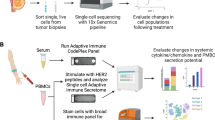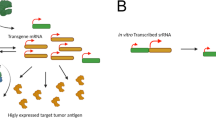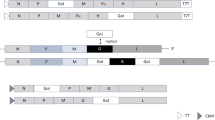Abstract
Alphavirus vectors have emerged as a promising strategy for the development of cancer vaccines and gene therapy applications. In this study, we used the replication-defective vaccine vector SIN replicon particles from a new packaging cell line (PCL) to develop SIN replicon particles encoding calreticulin (CRT) linked to a model tumor antigen, human papillomavirus type 16 (HPV16) E7 protein. The linkage of CRT to E7 in SIN replicon particles resulted in a significant increase in E7-specific CD8+ T-cell precursors and a strong antitumor effect against E7-expressing tumors in vaccinated mice. SINrep5-CRT/E7 replicon particles enhanced presentation of E7 through the major histocompatibility complex (MHC) class I pathway by infecting dendritic cells (DCs) directly and pulsing DCs with lysates of cells infected by SINrep5-CRT/E7 replicons. Vaccination of immunocompromised (BALB/c nu/nu) mice with SINrep5-CRT/E7 replicon particles also generated significant reduction of lung tumor nodules, suggesting that antiangiogenesis may contribute to the antitumor effect of SINrep5-CRT/E7 replicon particles. Furthermore, SINrep5-CRT/E7 replicon particles generated long-term in vivo tumor protection effects and antigen-specific memory immunities. We concluded that the CRT strategy used in the context of SIN replicon particles facilitated the generation of a highly effective vaccine for cancer prophylaxis and immunotherapy.
This is a preview of subscription content, access via your institution
Access options
Subscribe to this journal
Receive 12 print issues and online access
$259.00 per year
only $21.58 per issue
Buy this article
- Purchase on Springer Link
- Instant access to full article PDF
Prices may be subject to local taxes which are calculated during checkout








Similar content being viewed by others
References
Nash PD, Opas M, Michalak M . Calreticulin: not just another calcium-binding protein. Mol Cell Biochem 1994; 135: 71–78.
Spee P, Neefjes J . TAP-translocated peptides specifically bind proteins in the endoplasmic reticulum, including gp96, protein disulfide isomerase and calreticulin. Eur J Immunol 1997; 27: 2441–2449.
Sadasivan B, Lehner PJ, Ortmann B, Spies T, Cresswell P . Roles for calreticulin and a novel glycoprotein, tapasin, in the interaction of MHC class I molecules with TAP. Immunity 1996; 5: 103–114.
Basu S, Srivastava PK . Calreticulin, a peptide-binding chaperone of the endoplasmic reticulum, elicits tumor- and peptide-specific immunity. J Exp Med 1999; 189: 797–802.
Cheng WF, Hung CF, Chai CY, Hsu KF, He L, Ling M et al. Tumor-specific immunity and antiangiogenesis generated by a DNA vaccine encoding calreticulin linked to a tumor antigen. J Clin Invest 2001; 108: 669–678.
Lukas J, Muller H, Bartkova J, Spitkovsky D, Kjerulff AA, Jansen DP et al. DNA tumor virus oncoproteins and retinoblastoma gene mutations share the ability to relieve the cell's requirement for cyclin D1 function in G1. J Cell Biol 1994; 125: 625–638.
Xiong C, Levis R, Shen P, Schlesinger S, Rice CM, Huang HV . Sindbis virus: an efficient, broad host range vector for gene expression in animal cells. Science 1989; 243: 1188–1191.
Hariharan MJ, Driver DA, Townsend K, Brumm D, Polo JM, Belli BA et al. DNA immunization against herpes simplex virus: enhanced efficacy using a Sindbis virus-based vector. J Virol 1998; 72: 950–958.
Berglund P, Quesada-Rolander M, Putkonen P, Biberfeld G, Thorstensson R, Liljestrom P . Outcome of immunization of cynomolgus monkeys with recombinant Semliki Forest virus encoding human immunodeficiency virus type 1 envelope protein and challenge with a high dose of SHIV-4 virus. AIDS Res Hum Retroviruses 1997; 13: 1487–1495.
Daemen T, Pries F, Bungener L, Kraak M, Regts J, Wilschut J . Genetic immunization against cervical carcinoma: induction of cytotoxic T lymphocyte activity with a recombinant alphavirus vector expressing human papillomavirus type 16 E6 and E7. Gene Therapy 2000; 7: 1859–1866.
Strauss JH, Strauss EG . The alphaviruses: gene expression, replication, and evolution. Microbiol Rev 1994; 58: 491–562.
Schlesinger S, Dubensky TW . Alphavirus vectors for gene expression and vaccines. Curr Opin Biotechnol 1999; 10: 434–439.
Frolov I, Hoffman TA, Pragai BM, Dryga SA, Huang HV, Schlesinger S et al. Alphavirus-based expression vectors: strategies and applications. Proc Natl Acad Sci USA 1996; 93: 11371–11377.
Ying H, Zaks TZ, Wang RF, Irvine KR, Kammula US, Marincola FM et al. Cancer therapy using a self-replicating RNA vaccine. Nat Med 1999; 5: 823–827.
Onate AA, Donoso G, Moraga-Cid G, Folch H, Cespedes S, Andrews E . An RNA vaccine based on recombinant Semliki Forest virus particles expressing the Cu,Zn superoxide dismutase protein of Brucella abortus induces protective immunity in BALB/c mice. Infect Immun 2005; 73: 3294–3300.
Wang X, Wang JP, Maughan MF, Lachman LB . Alphavirus replicon particles containing the gene for HER2/neu inhibit breast cancer growth and tumorigenesis. Breast Cancer Res 2005; 7: R145–R155.
Yamanaka R, Xanthopoulos KG . Induction of antigen-specific immune responses against malignant brain tumors by intramuscular injection of Sindbis DNA encoding gp100 and IL-18. DNA Cell Biol 2005; 24: 317–324.
Reed DS, Lind CM, Lackemeyer MG, Sullivan LJ, Pratt WD, Parker MD . Genetically engineered, live, attenuated vaccines protect nonhuman primates against aerosol challenge with a virulent IE strain of Venezuelan equine encephalitis virus. Vaccine 2005; 23: 3139–3147.
Pushko P, Parker M, Ludwig GV, Davis NL, Johnston RE, Smith JF . Replicon-helper systems from attenuated Venezuelan equine encephalitis virus: expression of heterologous genes in vitro and immunization against heterologous pathogens in vivo. Virology 1995; 239: 389–401.
Ling M, Kanayama M, Roden R, Wu TC . Preventive and therapeutic vaccines for HPV-associated cervical cancers. J Biomed Sci 2000; 7: 341–356.
Polo JM, Belli BA, Driver DA, Frolov I, Sherrill S, Hariharan MJ et al. Stable alphavirus packaging cell lines for Sindbis virus and Semliki Forest virus-derived vectors. Proc Natl Acad Sci USA 1999; 96: 4598–4603.
Lin KY, Guarnieri FG, Staveley-O'Carroll KF, Levitsky HI, August T, Pardoll DM et al. Treatment of established tumors with a novel vaccine that enhances major histocompatibility class II presentation of tumor antigen. Cancer Res 1996; 56: 21–26.
Bredenbeek PJ, Frolov I, Rice CM, Schlesinger S . Sindbis virus expression vectors: packaging of RNA replicons by using defective helper RNAs. J Virol 1993; 67: 6439–6446.
Cheng WF, Hung CH, Chai CY, Hsu KF, He L, Ling M et al. Enhancement of Sindbis virus self-replicating RNA vaccine potency by linkage of herpes simplex virus type 1 VP22 protein to antigen. J Virol 2001; 75: 2368–2376.
Wu TC, Guarnieri FG, Staveley-O'Carroll KF, Viscidi RP, Levitsky HI, Hedrick L et al. Engineering an intracellular pathway for MHC class II presentation of HPV-16 E7. Proc Natl Acad Sci 1995; 92: 11671–11675.
Cheng WF, Hung CF, Chai CY, Hsu KF, He L, Rice CM et al. Enhancement of Sindbis virus self-replicating RNA vaccine potency by linkage of Mycobacterium tuberculosis heat shock protein 70 gene to an antigen gene. J Immunol 2001; 166: 6218–6226.
Gardner JP, Frolov I, Perri S, Ji Y, MacKichan ML, zur Megede J et al. Infection of human dendritic cells by a Sindbis virus replicon vector is determined by a single amino acid substitution in the E2 glycoprotein. J Virol 200; 74: 11849–11857.
Cheng WF, Hung CF, Hsu KF, Chai CY, He L, Polo JM et al. Cancer immunotherapy using Sindbis virus replicon particles encoding a VP22-antigen fusion. Hum Gene Ther 2002; 13: 553–568.
Feltkamp MC, Smits HL, Vierboom MP, Minnaar RP, Jongh B, Drijfhout JW et al. Vaccination with cytotoxic T lymphocyte epitope-containing peptide protects against a tumor induced by human papillomavirus type 16-transformed cells. Eur J Immunol 1993; 23: 2242–2249.
Tindle RW, Fernando GJ, Sterling JC, Frazer IH . A ‘public’ T-helper epitope of the E7 transforming protein of human papillomavirus 16 provides cognate help for several E7 B-cell epitopes from cervical cancer-associated human papillomavirus genotypes. Proc Natl Acad Sci USA 1991; 88: 5887–5891.
Cheng WF, Hung CF, Hsu KF, Chai CY, He L, Ling M et al. Enhancement of Sindbis virus self-replicating RNA vaccine potency by targeting antigen to endosomal/lysosomal compartments. Hum Gene Ther 2001; 12: 235–252.
Cheng WF, Hung CF, Lin KY, Ling M, Juang J, He L et al. CD8+ T cells, NK cells and IFN-gamma are important for control of tumor with downregulated MHC class I expression by DNA vaccination. Gene Therapy 2003; 10: 1311–1320.
Dialynas DP, Quan ZS, Wall KA, Pierres A, Quintans J, Loken MR et al. Characterization of the murine T cell surface molecule, designated L3T4, identified by monoclonal antibody GK1.5: similarity of L3T4 to the human Leu-3/T4 molecule. J Immunol 1983; 131: 2445–2451.
Sarmiento M, Glasebrook AL, Fitch FW . IgG or IgM monoclonal antibodies reactive with different determinants on the molecular complex bearing Lyt 2 antigen block T cell-mediated cytolysis in the absence of complement. J Immunol 1980; 125: 2665–2772.
Koo GC, Dumont FJ, Tutt M, Hackett Jr J, Kumar V . The NK-1.1 (−) mouse: a model to study differentiation of murine NK cells. J Immunol 1986; 137: 3742–3747.
Coughlin CM, Salhany KE, Wysocka M, Aruga E, Kurzawa H, Chang AE et al. Interleukin-12 and interleukin-18 synergistically induce murine tumor regression which involves inhibition of angiogenesis. J Clin Invest 1998; 101: 1441–1452.
Hung CF, Cheng WF, He L, Ling M, Juang J, Lin CT et al. Enhancing major histocompatibility complex class I antigen presentation by targeting antigen to centrosomes. Cancer Res 2003; 63: 2393–2398.
Albert ML, Pearce SF, Francisco LM, Sauter B, Roy P, Silverstein RL et al. Immature dendritic cells phagocytose apoptotic cells via alphavbeta5 and CD36, and cross-present antigens to cytotoxic T lymphocytes. J Exp Med 1998; 188: 1359–1368.
Albert ML, Sauter B, Bhardwaj N . Dendritic cells acquire antigen from apoptotic cells and induce class I- restricted CTLs. Nature 1998; 392: 86–89.
Huang AY, Golumbek P, Ahmadzadeh M, Jaffee E, Pardoll D, Levitsky H . Role of bone marrow-derived cells in presenting MHC class I-restricted tumor antigens. Science 1998; 264: 961–965.
Srivastava PK, Udono H, Blachere NE, Li Z . Heat shock proteins transfer peptides during antigen processing and CTL priming. Immunogenetics 1994; 39: 93–98.
Harwerth IM, Wels W, Schlegel J, Muller M, Hynes NE . Monoclonal antibodies directed to the erbB-2 receptor inhibit in vivo tumour cell growth. Br J Cancer 1993; 68: 1140–1145.
Moulton HM, Yoshihara PH, Mason DH, Iversen PL, Triozzi PL . Active specific immunotherapy with a beta-human chorionic gonadotropin peptide vaccine in patients with metastatic colorectal cancer: antibody response is associated with improved survival. Clin Cancer Res 2002; 8: 2044–2051.
Berinstein NL . Carcinoembryonic antigen as a target for therapeutic anticancer vaccines: a review. J Clin Oncol 2002; 20: 2197–2207.
Dermime S, Gilham DE, Shaw DM, Davidson EJ, Meziane El-K, Armstrong A et al. Vaccine and antibody-directed T cell tumour immunotherapy. Biochim Biophys Acta 2004; 1704: 11–35.
Curtsinger JM, Lins DC, Mescher MF . CD8+ memory T cells (CD44high, Ly-6C+) are more sensitive than naive cells to (CD44low, Ly-6C−) to TCR/CD8 signaling in response to antigen. J Immunol 1998; 160: 3236–3243.
Feuerer M, Beckhove P, Bai L, Solomayer EF, Bastert G, Diel IJ et al. Therapy of human tumors in NOD/SCID mice with patient-derived reactivated memory T cells from bone marrow. Nat Med 2001; 7: 452–458.
Acknowledgements
Dr Wen-Fang Cheng (RE88P005) is a recipient of the NHRI physician scientist fellowship award. This work was supported by a grant from National Taiwan University Hospital (NTUH91A05).
Author information
Authors and Affiliations
Corresponding author
Rights and permissions
About this article
Cite this article
Cheng, WF., Lee, CN., Su, YN. et al. Sindbis virus replicon particles encoding calreticulin linked to a tumor antigen generate long-term tumor-specific immunity. Cancer Gene Ther 13, 873–885 (2006). https://doi.org/10.1038/sj.cgt.7700956
Received:
Revised:
Accepted:
Published:
Issue Date:
DOI: https://doi.org/10.1038/sj.cgt.7700956
Keywords
This article is cited by
-
Adenovirus-mediated delivery of CALR and MAGE-A3 inhibits invasion and angiogenesis of glioblastoma cell line U87
Journal of Experimental & Clinical Cancer Research (2012)
-
Calreticulin exposure dictates the immunogenicity of cancer cell death
Nature Medicine (2007)



